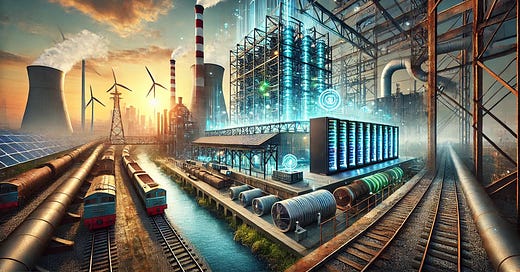From steel to silicon: How America’s industrial history is revolutionizing data centers of the future
Across America’s Rust Belt, a new chapter is unfolding in the story of data center development
Where steel mills once dominated the landscape, data centers are now taking root. The sounds of heavy manufacturing have been replaced by the quiet operation of servers and cooling systems. This shift represents not just a change in the region’s economic focus, but a potential revitalization of areas that have faced economic challenges in recent decades.
As the CEO of a publicly-traded digital infrastructure company, I’ve had a front-row seat to this transformation. The story of Midland, Pennsylvania, exemplifies this change. Like many towns in the region, Midland saw its fortunes decline with the departure of heavy industry. But where others had forgotten the rich industrial history of the area, we saw ample opportunities.
The rise of artificial intelligence (AI) and high-performance computing (HPC) has created an insatiable demand for power-ready sites offering a reliable source of clean carbon-free energy. These AI workloads often consume up to ten times more power per square foot than traditional data centers. As we explored potential sites for our expansion into the AI and HPC markets, we realized that the Rust Belt’s industrial past had inadvertently laid the groundwork for a digital future.
Our Midland facility, about 30 minutes from Pittsburgh International Airport, is situated on the site of a former steel mill, whose location offered several advantages for our data center operations. The existing electrical infrastructure, including high-capacity power lines and substations, can support the substantial energy needs of AI computing. The facility’s proximity to the Ohio River provides a favorable temperate weather location. Additionally, its position within the PJM (Pennsylvania- New Jersey- Maryland Interconnection) energy market, the largest wholesale electric market in the US, allows us to access competitive energy rates and a growing portfolio of renewable energy sources. These factors made the site an ideal location for efficiently repurposing existing industrial infrastructure to meet modern technology needs.
Perhaps the most valuable resource we’ve found isn’t the infrastructure or the continued opportunities for expansion — it’s the people. We have seen former steelworkers retrain as data center technicians and network engineers. Their work ethic and technical aptitude, honed over generations in manufacturing, have proven invaluable as we’ve scaled our operations.
Our approach to building these data centers has evolved too. We’ve embraced an agile design approach that allows for rapid deployment and easy scalability. This enabled us to expedite our plans in a fraction of the time required for traditional construction, allowing us to respond quickly to the fast-changing demands of the AI and digital assets industries.
The impact of this digital transformation extends far beyond data centers. In towns where digital infrastructure facilities are being built across the industrial heartland of America, we see a ripple effect in local economies. New jobs are being created and local businesses, from restaurants to hardware stores, see increased activity. There’s a palpable sense of optimism in communities that had long felt left behind by the digital economy.
The impact of this digital transformation extends far beyond data centers. In towns where digital infrastructure facilities are being built across the industrial heartland of America, we see a ripple effect in local economies.
Of course, this transition hasn’t been without its challenges. Repurposing these industrial sites often requires an innovative and open mindset to configure systems to the standards of modern data centers. From hardware, software, and systems, it often requires a different approach to optimize overall operations for the unique demands of accelerated compute workloads.
The Rust Belt’s second act as a silicon powerhouse is just beginning, and our experience has shown us the potential of these former industrial sites. The robust infrastructure, strategic locations, and skilled workforce make them ideal for the demands of modern data centers. We’re not just repurposing these sites and facilities — we’re reimagining the future of these communities.
Moreover, a commitment to sustainability aligns well with the growing demand for green energy solutions. By encouraging the growth of PJM market’s portfolio of renewable energy sources, we can not only power our data centers more efficiently but also contributing to the overall reduction of carbon emissions in the region. We are proud to use carbon-free energy and it remains a strategic imperative from our perspective.
As we look ahead, we see a bright future for the Rust Belt in the age of AI and high-performance computing. The same qualities that made this region the heart of American manufacturing — its strategic location, robust infrastructure, and hardworking people — are now positioning it to be at the forefront of the digital revolution.
It’s a testament to the resilience and adaptability of American industry and innovation. As we continue to grow and evolve, we remain committed to being good stewards of this legacy, building a future that honors the past while embracing the possibilities of tomorrow.
As we look to the future, the potential for growth seems boundless. Industry analysts predict the global AI market will reach $827 billion by 2030, growing at an annual rate of 29 percent. The story of the Rust Belt’s reinvention is still being written, but it’s clear that the next chapter will be driven by silicon as much as steel. It’s a powerful reminder that the best innovation often comes from unexpected places, and that the foundations of our AI-driven future are being built on the bedrock of America’s industrial past.
This article was originally published in Data Dynamics by Rahul Mewawalla. Rahul Mewawalla, a technology and business leader, is the CEO and President of Mawson Infrastructure Group (NASDAQ: MIGI), a publicly-traded digital infrastructure company in the artificial intelligence (AI), high-performance computing (HPC), and digital assets markets. He was previously at Yahoo, Nokia, and General Electric Company and has served as a business and technology leader across high-growth and transformative technology companies. He also served as Senior Advisor on Innovation to the San Francisco Mayor’s Office and Chair of the Venture Capital Task Force Committee on Services and Systems.






